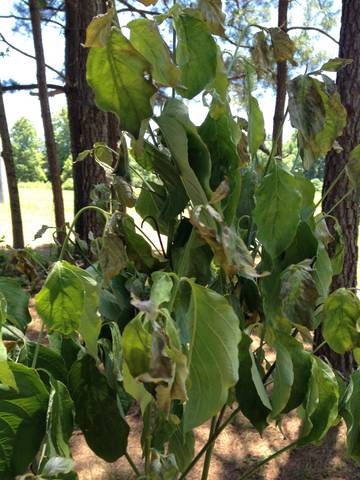Ask An Arborist: June 21, 2012
Ron in Gainesville writes that the young dogwoods in his landscape are showing signs of stress by wilting and have a white substance on them. While his dogwoods may indeed have powdery mildew, which we covered in
the June 7 newsletter, I see a much more potentially harmful situation occurring.
First let me say that I hate trying to diagnose plant problems via pictures and descriptions on the internet. Some problems are common and easily identified, but others are problematic as with Ron's dogwoods. A site
visit by a Certified Arborist is always the best first step in dealing with such problems. Since I am now living in Montana, I can't make that visit. That being said, I do believe I see powdery mildew which is very
common on dogwoods. Powdery mildew (on crape myrtles) was discussed in the
June 7 newsletter.
Even severe cases of powdery mildew don't usually cause this degree of wilt as seen in the picture. It appears that the trees are growing in at least partial shade, so extreme sun exposure probably isn't the cause.
It's possible that very dry soil is contributing to this, but I am also seeing some disturbing discolorations on the leaves which makes me wonder if the trees are infected with some type of anthracnose.
Anthracnose disease in dogwoods is caused by several species of fungi. All of these weaken the tree and in the case of discula anthracnose (Discula destructiva), the disease is deadly causing the loss of millions
of dogwoods in the
Appalachians and in the Piedmont of Georgia extending all the way into metro Atlanta. All anthracnose diseases start with a purple/brown spotting on the leaves and/or flowers which often spreads to the whole leaf or flower.
Wilting is sometimes seen and loss of infected leaves and flowers is common. Spot anthracnose, the less severe disease, is common on stressed trees, in wet weather and on trees that are in deeper shade with little air
circulation. Discula anthracnose continues spreading into the twigs and branches. Positive identification is best performed by an arborist or by taking an infected sample to your local Extension office. Use of fungicides
on spot anthracnose does provide a measure of control.
My recommendations to Ron are to examine the environment of these dogwoods. Are they growing in good soil, do they receive adequate moisture and have adequate mulch? I would definitely treat them for powdery mildew with
an appropriate fungicide, but I would also take an affected twig/leaf sample to the
Hall County Extension Service for a more detailed diagnosis.
If you are concerned about the trees in your landscape, you can contact a Certified Arborist or a professional tree company in
your area through the web site of the
Georgia Arborist Association.
If you have comments or questions about this article or want to submit a question that may be used in a future article, please
email me.
Unless otherwise noted, Images & Drawings Copyrighted © 2012 by Theresa Schrum - All rights reserved

